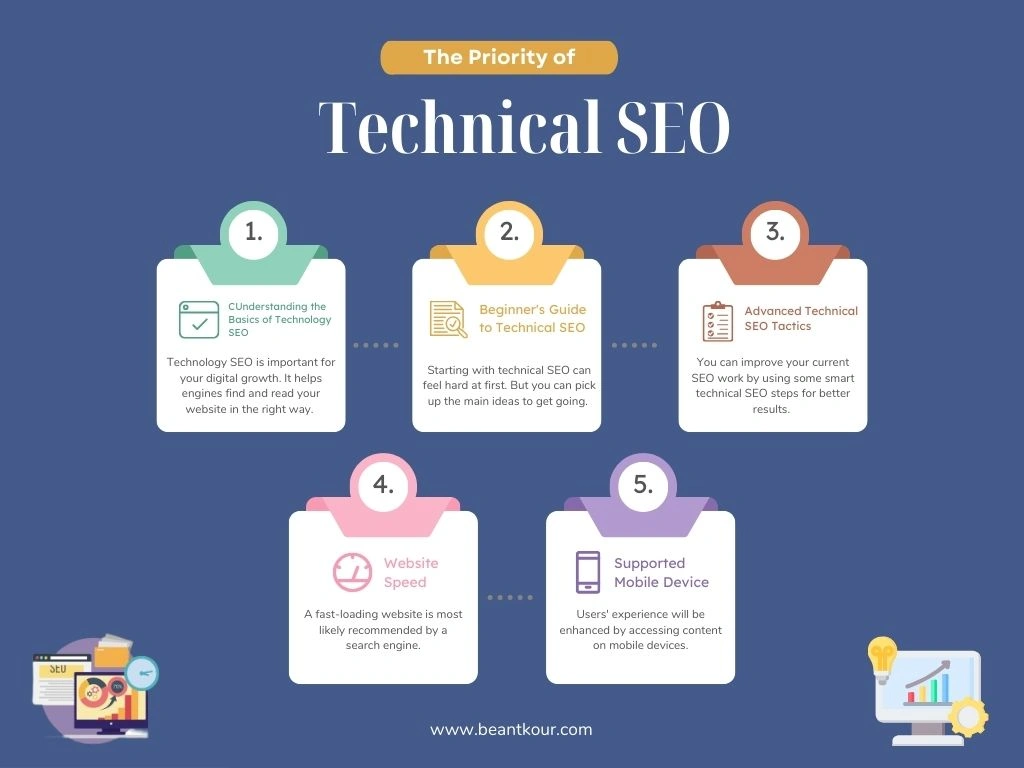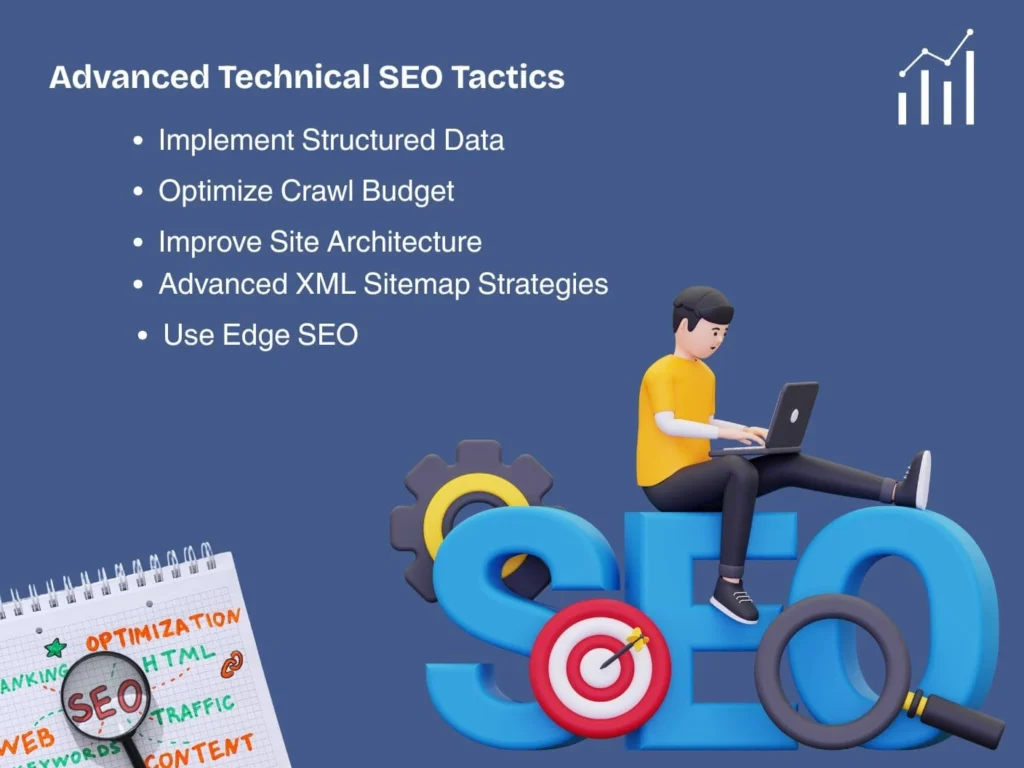Technical SEO Introduction
When you work on SEO, there is technical optimization that helps your site top Google search results. This work happens in the background. Technical SEO deals with the originality of your site in things people don’t often see, such as how your site is built and how it operates fast enough. It’s not about keyword documentation or content material. If there are problems with crawlability, page speed or phones working on your site, your site may not appear as well. It may also be difficult for such people to use your site.

This is how Specialist technology SEO Position for you. It explains why it’s important for a good website. If you want to know why your site appears better in Google, start here. There’s a lot you can do to help your site top the search results. Let’s see what it takes and how you can still make it better.
Understanding the Basics of Technology SEO
Technology SEO is important for your digital growth. It helps engines find and read your website in the right way. It doesn’t involve how your website looks. It’s about how your site talks to the Google search engine. With technical SEO, the marketing process can be easier and your page speed can be improved. It works on the Scotland based stages that are important to the way your site works.
When you use technology SEO, you can move up in search engine rankings. It Guides people search your site on the internet. If you have the right tools and use the best utility, your site can work well and stay ahead of the records. Technical SEO helps your site move forward in a better way.
What is Technology SEO?
Technical SEO ensures that the parts of your website that work in the background help engines like Google fix your page and read it in search. This is important so that the search page looks attractive. Search involves making it hard to visit or read your blog posts, product pages, and other key content that bots and crawlers should be searching for. Then, you need to fix those problems.
Technical SEO is all about a few important steps. You should have a clear XML sitemap. This lets crawlers know where to go on the site. Check your robots.txt so search engines see just the part you want. People should use HTTPS to keep the site secure. These steps help keep your website in good shape, help it load better, prevent crawl stacks and reduce your SEO.
Technical SEO also helps you get used to working correctly with these machinery search. This can include the use of Standard tags to fix Copy content Questions. It can also mean using canonical markup so that your content appears as a rich snippet on Google search. The main goal is to get to the right page and show people what they want. Even the best blog posts or product suggestions on Google above may not be shown if your website is not set up correctly.
When you work on technology SEO, you help make your site better for both people and bots. For this, you can make all the pages of your website accessible to these search engines. When you do this, you give your site a better chance of appearing in search results. More people may click on your blog, other main content and content. This can help you get more visits and attention online.
Importance of Technology SEO in Digital Marketing
Technology SEO is an important part of digital marketing. It helps your content be retrieved more easily. This ensures that your site works well with engines like Google. This allows you to get more people to your website from search. It also helps you get more sales or leads. For this reason, it is a big part of any marketing plan.
A good example of this is when a website loads fast and is easy for you to control. People often stay on the site longer and the number of people leaving quickly decreases. This can help you get better customer sales over time. If you use recorded data, your content can have rich Excerpts. Technical SEO helps with this because it allows more people to click through to your site from Google.
If you are not paying attention to technical SEO, things like crawlability, stocking, and rankings can suffer. It can be Complicated for search engines to find your site. This can lead to poor results. But when you use mobile and mobile-optimized XML sitemap tools over HTTPS, you improve the technical health of your site.
Beginner’s Guide to Technical SEO

Starting with technical SEO can feel hard at first. But you can pick up the main ideas to get going. Tools like Google Search Console and PageSpeed Insights help you see what can keep your site from doing well on Google search.
You can start with small steps. First, make sure the site uses a secure HTTPS connection. Also, check that your website works well on mobile devices. This helps people get a good experience when they are on their phones. After you handle these basics, you can go further. Use tools like schema markup to help your site show rich snippets in Google. Branch to the best Methods and use easy tools. This way, you can boost your website and help it show up more in search results. Even with small changes, your site can grow over time in the rankings.
Essential Tools and Resources Needed
There are many tools that make technical SEO jobs easier. These tools help your site reach its main needs for how it works. Popular choices like Google Search Console let you see when your pages show up in Google search. They also let you fix crawlability problems and look at which pages are covered.
Another tool you should know about is Page Speed Insights. It Assessments the speed of your site on both mobile. This can help you see where there are slow parts on your site. If you want to make your website load faster, you can use other things, too. Try Image compressor to make the size of your images smaller. You can also use Cloudflare to set up a CDN. This will help get your content to people around the world faster.
Step-by-step Guide to Implementing Technical SEO
Technical SEO by doing a few Essential things that help fix Index errors, indexing problems, and any Problems in how your site works. First, look at your site with tools like SEO analysis tool SEMrush or Screaming Frog. When you do this, you can see the weak spots that bring down your SEO rankings.
Next, look after things like broken links and double content. These can keep Google and other search engines from looking at your site the way you want. Make sure the XML sitemaps and robots.txt files are set up right. This can help search engines read your site better. use SSL certificates and move your site to HTTPS. When you do this, it can make your site safer, and now, this is a big factor in how search engines rank your site.
At last, work on how fast your site loads and how it looks on phones and tablets. Use PageSpeed Insights and some other tools to help you find where to start. Make your images smaller, turn on caching, and get rid of duplicate URLs. When you use these ways, you give people and search engines a better and easier time moving around your website. This will help make your site smooth, simple, and easy to use for everyone.
Step 1: Conduct a Site Audit for Technical Health
Look at the “Scope” report in Google Search Console to find Scan problems. You need to see if there are any pages that are left out or not showing up the right way. If you find mistakes, you should fix them fast. A good audit will help you see if there are any problems with links to other websites, 404 pages, and how fast your pages load. Doing this helps your site stay in good shape with search engines.
Fix broken links with redirects. Also, take care of any duplicate URLs because these can hurt your rankings. If you do regular audits, you can stay away from Google algorithm penalties. This will help your rankings go up. A website with strong technical health will be ready for changes in search engines like Google and any other updates.
Step 2: Optimize Site Structure and Navigation
Start by making a simple design for the site. This helps search engines know how the pages connect. Put your most important content where people can find it fast. It will also be good for algorithms.
Breadcrumb trails and clear URLs help make web pages easy to use. A product page can show groups or categories such as “Books > Fiction > Thriller” at the top. This helps people know where they are on the site. It also helps make their experience on the site better. It lets search engines read your site more easily, so people do not get lost or feel confused.
Internal linking helps make your site strong. It lets Google’s crawlers find your best pages fast. A tool like Screaming Frog can show you the pages that don’t have any links or where the navigation is hard to use. When you fix the structure of your site, your ranking in search gets better. People can also use your site more easily at the same time.
Step 3: Ensure Mobile Responsiveness and Speed
Many people now use their phones to go online, so mobile responsiveness is very important for technical SEO. Google uses its own systems that put the mobile experience at the top when choosing what websites to show first. You should use responsive designs to make sure your website looks good and works well on any screen.
This tool lets you see what is making it slow. The Core Web Vitals numbers, like Largest Contentful Paint and high bounce rates, tell you what you should fix on your mobile site. You can help things get better if you lower the size of big scripts and use browser caching.
Mobile users want pages to load fast. They also want big buttons that are easy to tap and layouts that are simple. If you do these things, your top pages will load faster and stay easy to use. When your mobile speed gets better, people spend more time on your site. This can also help your SEO rankings
Key Components of Technical SEO
XML sitemaps let search engines find and add your website pages fast and easily. Robots.txt lets you say what the crawlers can or cannot see on your site. When you use HTTPS, there is more safety for you and your users.
This can help your site get more notice in the search results with rich snippets. Canonical tags help avoid issues with having the same content on different URLs. They show the bots which is the main URL, so your work is not lost among copies and people can see your main page. When you work on these things, you keep your technical health in good shape. This also helps your website’s SEO and gives your site more visibility.
Role of SSL Certificates and Web Security
SSL certificates and HTTPS make your site look safe to people. They help keep important things, like your data, away from others who want to steal it. Google and the people who come to your site can see that it is safe.
HTTPS protects your data when it moves from one place to another. It helps keep people from stealing your data as it goes. For example, when your website lets people log in with a username and password, you need an SSL certificate. This keeps what they share with you safe. If you switch your site from HTTP to HTTPS, Google can see your website in a better way.
You should also check your website for problems. Look for old plugins and pages that are the same. Fix these things to make the site work well. This helps Consumers trust your site and Preserves them coming back. It can also help your Google rankings.
Advanced Technical SEO Tactics

You can improve your current SEO work by using some smart technical SEO steps for better results. When you add schema markup to your products, ratings, and blog posts, this helps show important data in search results. It leads to rich snippets. These rich snippets can make your blog, products, and ratings look different from others. This way, more people will notice you in their search results.
Also, try to use the crawl budget in a better way. If you see how Google is indexing your site, you can get bots to go to the important pages and not to pages that do not matter as much. When you use these technical SEO tips, you will see your rankings go up. Your SEO will get better, and your blog and business will do well in search results.
Leveraging Structured Data and Schema Markup
Structured data helps crawlers from search engines read the content on your site. Schema markup lets you put tags on things like star ratings, product lists, and event times. Because of this, rich snippets show up more often in Google search results. People can see these extra details when they search.
Tools like Google Tag Team leader let you put Framework markup on your site. You do not have to know coding for this. You can tag your product listings or show star ratings for reviews. This helps your site be seen more and can bring in quick clicks.
As search engines improve, using structured data helps with indexing. If you add schema to your site, it will keep your listings clear and organized. This can help raise your click rates. It can also help your business grow because your listings become more useful and richer.
Managing Crawl Budget and Site Indexing
Crawl budget is about how often google and other search engines’ bots visit your site. This is why you should work on your seo. If you have pages that you do not need, bots will go to them and slow down your site. Use the Machines. txt file to block Posts that are old or not needed. This helps the bots use their time better on the parts of the site that matter.
XML sitemaps tell Google bots about the best pages on your website. This helps the bots get to your important URLs first and not spend time on pages that are not needed. You can use Google Search Console to see all the reports. These reports show if there are problems with indexing. This way, you know what to fix to make crawling better.
If you use the right ways to handle this, your site will have the best pages picked up by Google. This helps your pages show up more and makes it easier for people to find your main pages when they search online.
Conclusion
In the end, learning technical SEO is very important for anyone who does digital marketing. It helps your website show up on search engines and gives people a better user experience. When you work on simple things like site structure, mobile-friendly design, and security, you make a stronger website. This will help your site do better in the busy online world.
When you go on and try more steps like adding structured data or choosing how search engines look at your site, these things can really help improve your search rankings. So, use technical SEO now to grow your online presence and help it stand out.
Repeatedly Asked Questions
What are the first steps in Understanding Technical SEO?
To get Initiated with technical SEO, you need to know the Fundamentals first. Understand what XML sitemaps are, what a Machines.txt file is, and how to make your website use HTTPS for extra Security. There are some good tools out there to help you with this, like Google Search Console and Page Speed Knowledge. These tools let you see any errors and find out what is important. Use what you get from them to work on the main points, like indexing and crawlability in Google search.
